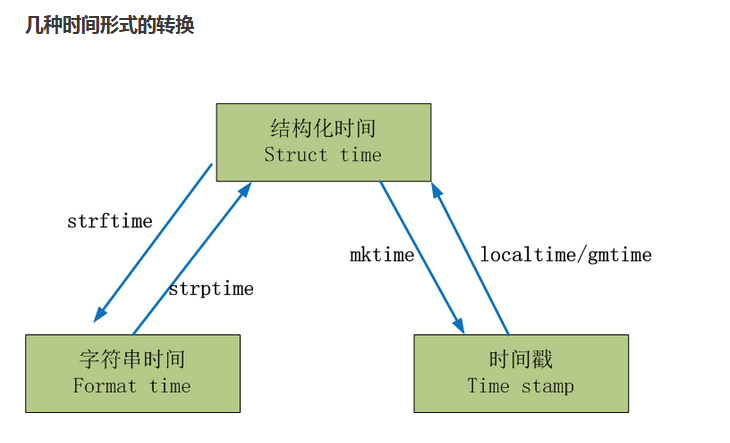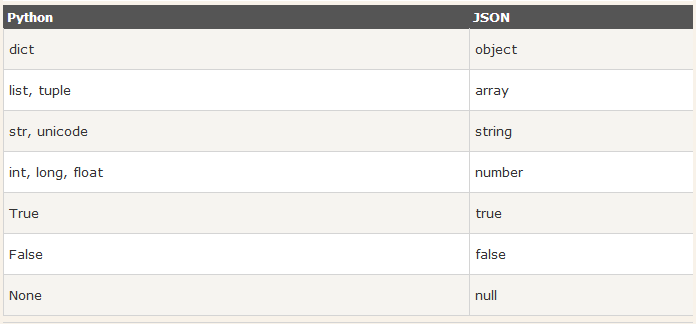7.python常用模块
time模块
常用表示时间方式: 时间戳,格式化的时间字符串,元组(struct_time)
UTC(Coordinated Universal Time,世界协调时)亦即格林威治天文时间,世界标准时间。在中国为UTC+8。DST(Daylight Saving Time)即夏令时。
时间戳(timestamp)的方式:通常来说,时间戳表示的是从1970年1月1日00:00:00开始按秒计算的偏移量。
元组(struct_time)方式:struct_time元组共有9个元素,返回struct_time的函数主要有gmtime(),localtime(),strptime()。

1. 时间戳转换成struct_time
>>> import time >>> time.time() 1513821691.159022 >>> time.gmtime() # 转换的是UTC时间 time.struct_time(tm_year=2017, tm_mon=12, tm_mday=21, tm_hour=2, tm_min=1, tm_sec=40, tm_wday=3, tm_yday=355, tm_isdst=0) >>> x = time.localtime() #转换的是本地时间(UTC+8) >>> print(x) time.struct_time(tm_year=2017, tm_mon=12, tm_mday=21, tm_hour=10, tm_min=1, tm_sec=49, tm_wday=3, tm_yday=355, tm_isdst=0) tm_wday(0-6) 星期一是0,星期天是6
2. struct_time转换成时间戳
>>> time.mktime(x) #x = time.localtime() 1513821709.0
3.struct_time转换成format_time
%a 本地(locale)简化星期名称 %A 本地完整星期名称 %b 本地简化月份名称 %B 本地完整月份名称 %c 本地相应的日期和时间表示 %d 一个月中的第几天(01 - 31) %H 一天中的第几个小时(24小时制,00 - 23) %I 第几个小时(12小时制,01 - 12) %j 一年中的第几天(001 - 366) %m 月份(01 - 12) %M 分钟数(00 - 59) %p 本地am或者pm的相应符 一 %S 秒(01 - 61) 二 %U 一年中的星期数。(00 - 53星期天是一个星期的开始。)第一个星期天之前的所有天数都放在第0周。 %w 一个星期中的第几天(0 - 6,0是星期天) 三 %W 和%U基本相同,不同的是%W以星期一为一个星期的开始。 %x 本地相应日期 %X 本地相应时间 %y 去掉世纪的年份(00 - 99) %Y 完整的年份 %Z 时区的名字(如果不存在为空字符) %% ‘%’字符
>>> import time >>> time.time() 1513822266.5659332 >>> x = time.localtime() >>> print(x) time.struct_time(tm_year=2017, tm_mon=12, tm_mday=21, tm_hour=10, tm_min=11, tm_sec=31, tm_wday=3, tm_yday=355, tm_isdst=0) >>> >>> time.strftime("%Y%m%d %H:%M:%S",x) '20171221 10:11:31' >>> #语法: #strftime(format,[tuple])
4 format_time转换成struct_time
>>> time.strftime("%Y%m%d %H:%M:%S",x) '20171221 10:11:31' >>> >>> >>> time.ct_time(tm_year=2017, tm_mon=12, tm_mday=21, tm_hour=10, tm_min=11, tm_sec=31, tm_wday=3, tm_yday=355, tm_isdst=-1)
用法:
strp('string',format
5.结构化时间转换成字符串时间

import time x = time.localtime() print(x) print(time.asctime(x)) 结果: time.struct_time(tm_year=2017, tm_mon=12, tm_mday=21, tm_hour=10, tm_min=29, tm_sec=58, tm_wday=3, tm_yday=355, tm_isdst=0) Thu Dec 21 10:29:58 2017
6.时间戳转换成字符串
>>> import time >>> time.time() 1513823679.9577746 >>> print(time.ctime()) Thu Dec 21 10:34:50 2017
random模块
>>> import random >>> random.random() # 0~1 随机浮点数 0.6990063739837862 >>> random.randint(1,7) #随机整数1~7 5 >>> random.randrange(1,7) #随机整数,不包括7 4 >>> random.choice('hello world') #获取一个随机元素 'l' >>> random.choice(['1','2','3',]) '2' >>> random.sample([1,2,3,4,5],3) [1, 2, 4] random.sample的函数原型为:random.sample(sequence, k),从指定 序列中随机获取指定长度的片
随机验证码
import random def v_code(): code = "" for i in range(4): num = random.randint(0,9) #随机选择0~9 A1Z1 = chr(random.randint(65,90)) #随机选择A~Z a1z1 = chr(random.randint(97,122)) #随机选择a~z add = random.choice([num,A1Z1,a1z1]) #随机选择其中一个 code = "".join([code,str(add)]) #拼接一次选到的元素 return code #返回验证码# print(v_code()) 结果: 5adc
OS模块
os.getcwd() #获取当前工作目录,即当前python脚本工作的目录路径 os.chdir() #当前目录 os.chdir("dirname") #改变当前脚本工作目录;相当于shell下cd os.chdir(r"c:\Users")
os.curdir #返回当前目录: ('.'),相当于shell下cd. os.pardir # 获取当前目录的父目录字符串名:('..'),相当于shell下cd.. 返回上一层目录 os.makedirs('dirname1/dirname2') #可生成多层递归目录 os.makedirs(r"c:\a\b\c") os.removedirs('dirname1') #若目录为空,则删除,并递归到上一级目录,如若也为空,则删除,依此类推 os.removedirs(r"c:\a\b\c") os.mkdir('dirname') #生成单级目录;相当于shell中mkdir dirname os.rmdir('dirname') # 删除单级空目录,若目录不为空则无法删除,报错;相当于shell中rmdir dirname os.listdir('dirname') #列出指定目录下的所有文件和子目录,包括隐藏文件,并以列表方式打印 os.listdir("c:\\test") os.remove() #删除一个文件 os.remove(r"c:\oldboy.txt") os.rename("oldname","newname") #重命名文件/目录 os.rename("c:\\test","c:\\test2") os.stat('path/filename') # 获取文件/目录信息 os.stat("c:\\test2") os.sep #输出操作系统特定的路径分隔符,win下为"\\",Linux下为"/" os.linesep #输出当前平台使用的行终止符,win下为"\r\n",Linux下为"\n" os.pathsep #输出用于分割文件路径的字符串 os.name #输出字符串指示当前使用平台。win->'nt'; Linux->'posix' os.system("bash command") #运行shell命令,直接显示 os.environ #获取系统环境变量 os.path.abspath(path) #返回path规范化的绝对路径 os.path.split(path) #将path分割成目录和文件名二元组返回 os.path.dirname(path) #返回path的目录。其实就是os.path.split(path)的第一个元素 os.path.basename(path) # 返回path最后的文件名。如何path以/或\结尾,那么就会返回空值。即os.path.split(path)的第二个元素 os.path.exists(path) #如果path存在,返回True;如果path不存在,返回False os.path.isabs(path) #如果path是绝对路径,返回True os.path.isfile(path) #如果path是一个存在的文件,返回True。否则返回False os.path.isdir(path) #如果path是一个存在的目录,则返回True。否则返回False os.path.join(path1[, path2[, ...]]) #将多个路径组合后返回,第一个绝对路径之前的参数将被忽略 os.path.getatime(path) #返回path所指向的文件或者目录的最后存取时间 os.path.getmtime(path) #返回path所指向的文件或者目录的最后修改时间 os.path.getsize(path) #返回path的大小
sys模块
sys.argv 命令行参数List,第一个元素是程序本身路径
sys.exit(n) 退出程序,正常退出时exit(0)
sys.version 获取Python解释程序的版本信息
sys.maxint 最大的Int值
sys.path 返回模块的搜索路径,初始化时使用PYTHONPATH环境变量的值
sys.platform 返回操作系统平台名称
shutil模块
高级的 文件、文件夹、压缩包 处理模块
shutil.copy(src, dst)
拷贝文件和权限
1 import shutil 2 3 shutil.copy('f1.log', 'f2.log')
shutil.copy2(src, dst)
拷贝文件和状态信息
shutil.copystat(src, dst)
仅拷贝状态的信息,包括:mode bits, atime, mtime, flags
shutil.copymode(src, dst)
仅拷贝权限。内容、组、用户均不变
shutil.copytree(src, dst, symlinks=False, ignore=None)
递归的去拷贝文件夹
shutil.rmtree(path[, ignore_errors[, onerror]])
递归的去删除文件
参考博客: http://www.cnblogs.com/linhaifeng/articles/6384466.html
Json和pickle模块
什么是序列化?
我们把对象(变量)从内存中变成可存储或传输的过程称之为序列化
为什么要序列化?
1:持久保存状态
需知一个软件/程序的执行就在处理一系列状态的变化,在编程语言中,'状态'会以各种各样有结构的数据类型(也可简单的理解为变量)的形式被保存在内存中。
内存是无法永久保存数据的,当程序运行了一段时间,我们断电或者重启程序,内存中关于这个程序的之前一段时间的数据(有结构)都被清空了。
在断电或重启程序之前将程序当前内存中所有的数据都保存下来(保存到文件中),以便于下次程序执行能够从文件中载入之前的数据,然后继续执行,这就是序列化。
具体的来说,你玩使命召唤闯到了第13关,你保存游戏状态,关机走人,下次再玩,还能从上次的位置开始继续闯关。或如,虚拟机状态的挂起等。
2:跨平台数据交互
序列化之后,不仅可以把序列化后的内容写入磁盘,还可以通过网络传输到别的机器上,如果收发的双方约定好实用一种序列化的格式,那么便打破了平台/语言差异化带来的限制,实现了跨平台数据交互。
反过来,把变量内容从序列化的对象重新读到内存里称之为反序列化,即unpickling。
JSON和Python内置的数据类型对应如下:

1 import json 2 3 dic={'name':'alvin','age':23,'sex':'male'} 4 print(type(dic))#<class 'dict'> 5 6 j=json.dumps(dic) 7 print(type(j))#<class 'str'> 8 9 10 f=open('序列化对象','w') 11 f.write(j) #-------------------等价于json.dump(dic,f) 12 f.close() 13 #-----------------------------反序列化<br> 14 import json 15 f=open('序列化对象') 16 data=json.loads(f.read())# 等价于data=json.load(f) import json #dct="{'1':111}"#json 不认单引号 #dct=str({"1":111})#报错,因为生成的数据还是单引号:{'one': 1} dct='{"1":"111"}' print(json.loads(dct)) #conclusion: # 无论数据是怎样创建的,只要满足json格式,就可以json.loads出来,不一定非要dumps的数据才能loads
实例
import json # 序列化 info = {'name':'derek','age':'22'} with open('test','w') as f: f.write(json.dumps(info)) # 反序列化 with open('test','r') as f: info = json.loads(f.read()) print(info)
pickle (它只能用于Python)
1 import pickle 2 3 dic={'name':'alvin','age':23,'sex':'male'} 4 5 print(type(dic))#<class 'dict'> 6 7 j=pickle.dumps(dic) 8 print(type(j))#<class 'bytes'> 9 10 11 f=open('序列化对象_pickle','wb')#注意是w是写入str,wb是写入bytes,j是'bytes' 12 f.write(j) #-------------------等价于pickle.dump(dic,f) 13 14 f.close() 15 #-------------------------反序列化 16 import pickle 17 f=open('序列化对象_pickle','rb') 18 19 data=pickle.loads(f.read())# 等价于data=pickle.load(f) 20 21 22 print(data['age'])
总结:
Json模块提供了四个功能:dumps、dump、loads、load
pickle模块提供了四个功能:dumps、dump、loads、load
dump()函数接受一个文件句柄和一个数据对象作为参数,把数据对象以特定的格式保存 到给定的文件中。当我们使用load()函数从文件中取出已保存的对象时,pickle知道如何恢复这些对象到它们本来的格式。
dumps()函数执行和dump() 函数相同的序列化。取代接受流对象并将序列化后的数据保存到磁盘文件,这个函数简单的返回序列化的数据。
loads()函数执行和load() 函数一样的反序列化。取代接受一个流对象并去文件读取序列化后的数据,它接受包含序列化后的数据的str对象, 直接返回的对象。
configparser模块
用于生成和修改常见配置文档
配置文件
[default] serveraliveinterval = 45 compression = yes compressionlevel = 9 [bitbucket.org] user = hg [topsecret.server.com] port = 50022 forwardx11 = no
用python生成这样的一个配置文档
import configparser
config = configparser.ConfigParser() config['default'] = {'ServerAliveInterval':'45', 'Compression':'yes', 'CompressionLevel':'9'}
config['bitbucket.org'] = {} config['bitbucket.org']['User'] = 'hg'
config['topsecret.server.com'] = {'port':'50022', 'Forwardx11':'no'}
with open('example.ini','w') as configfile: config.write(configfile)
读取
import configparser
config = configparser.ConfigParser() print(config.read('example.ini'))
#查看所有的标题 print(config.sections()) #['default', 'bitbucket.org', 'topsecret.server.com']
#查看标题section1下所有key=value的key
options = config.options('default') print(options) #['serveraliveinterval', 'compression', 'compressionlevel']
#查看标题section1下所有key=value的(key,value)格式 items_list = config.items('topsecret.server.com') print(items_list) #[('port', '50022'), ('forwardx11', 'no')]
增删改查
import configparser config = configparser.ConfigParser() config.read('example.ini',encoding = 'utf-8') #删除整个标题 config.remove_section('bitbucket.org') #删除标题下的option config.remove_option('topsecret.server.com','port') #添加一个标题 config.add_section('info') #在标题下添加options config.set('info','name','derek') #判断是否存在 print(config.has_section('info')) #True print(config.has_option('info','name')) #True #将修改的内容存入文件 config.write(open('new_example.ini','w'))
#修改后的文件 [default] serveraliveinterval = 45 compression = yes compressionlevel = 9 [topsecret.server.com] forwardx11 = no [info] name = derek
hashlib模块
hash:一种算法 ,3.x里代替了md5模块和sha模块,主要提供 SHA1, SHA224, SHA256, SHA384, SHA512 ,MD5 算法 三个特点: 1.内容相同则hash运算结果相同,内容稍微改变则hash值则变 2.不可逆推 3.相同算法:无论校验多长的数据,得到的哈希值长度固定。
1 import hashlib 2 3 m=hashlib.md5()# m=hashlib.sha256() 4 5 m.update('hello'.encode('utf8')) 6 print(m.hexdigest()) #5d41402abc4b2a76b9719d911017c592 7 8 m.update('alvin'.encode('utf8')) 9 10 print(m.hexdigest()) #92a7e713c30abbb0319fa07da2a5c4af 11 12 m2=hashlib.md5() 13 m2.update('helloalvin'.encode('utf8')) 14 print(m2.hexdigest()) #92a7e713c30abbb0319fa07da2a5c4af 15 16 ''' 17 注意:把一段很长的数据update多次,与一次update这段长数据,得到的结果一样 18 但是update多次为校验大文件提供了可能。
re模块

# 正则匹配 import re # \w与\W 字母数字下划线 print(re.findall('\w', 'hello derek \n 123')) print(re.findall('\W', 'hello derek \n 123')) # ['h', 'e', 'l', 'l', 'o', 'd', 'e', 'r', 'e', 'k', '1', '2', '3'] # [' ', ' ', '\n', ' '] # \s与\S 匹配任意空白字符 print(re.findall('\s', 'hello egon 123')) # [' ', ' ', ' ', ' '] print(re.findall('\S', 'hello egon 123')) # ['h', 'e', 'l', 'l', 'o', 'e', 'g', 'o', 'n', '1', '2', '3'] # \n \t都是空,都可以被\s匹配 print(re.findall('\s', 'hello \n egon \t 123')) # [' ', '\n', ' ', ' ', '\t', ' '] # \n与\t print(re.findall(r'\n', 'hello egon \n123')) # ['\n'] print(re.findall(r'\t', 'hello egon\t123')) # ['\n'] # \d与\D print(re.findall('\d', 'hello egon 123')) # ['1', '2', '3'] print(re.findall('\D', 'hello egon 123')) # ['h', 'e', 'l', 'l', 'o', ' ', 'e', 'g', 'o', 'n', ' '] # \A与\Z \A 匹配字符串开始 \Z 匹配字符串结束 print(re.findall('\Ahe', 'hello egon 123')) # ['he'],\A==>^ print(re.findall('123\Z', 'hello egon 123')) # ['he'],\Z==>$ # ^与$ print(re.findall('^h', 'hello egon 123')) # ['h'] print(re.findall('3$', 'hello egon 123')) # ['3'] # 重复匹配:| . | * | ? | .* | .*? | + | {n,m} | # . 匹配任意字符,除了换行符,除非re.DOTALL标记 print(re.findall('a.b', 'a1b')) # ['a1b'] # a和b中间匹配任意一个字符 print(re.findall('a.b', 'a1b a*b a b aaab')) # ['a1b', 'a*b', 'a b', 'aab'] print(re.findall('a.b', 'a\nb')) # [] print(re.findall('a.b', 'a\nb', re.S)) # ['a\nb'] print(re.findall('a.b', 'a\nb', re.DOTALL)) # ['a\nb']同上一条意思一样 print(re.findall('a...b', 'a123b')) # ['a123b'] # *匹配*号前的字符0次或多次 print(re.findall('ab*', 'bbbbbbb')) # [] print(re.findall('ab*', 'a')) # ['a'] print(re.findall('ab*', 'abbbb')) # ['abbbb'] print(re.findall('ab*', 'abababbabbbb')) # ['ab', 'ab', 'abb', 'abbbb'] # ? 匹配前一个字符1次或0次 print(re.findall('ab?', 'a')) # ['a'] print(re.findall('ab?', 'abbb')) # ['ab'] # 匹配所有包含小数在内的数字 print(re.findall('\d+\.?\d*', "asdfasdf123as1.13dfa12adsf1asdf3")) # ['123', '1.13', '12', '1', '3'] # .*默认为贪婪匹配 print(re.findall('a.*b', 'a1b22222222b')) # ['a1b22222222b'] # .*?为非贪婪匹配:推荐使用 print(re.findall('a.*?b', 'a1b22222222b')) # ['a1b'] # + 匹配前一个字符1次或多次 print(re.findall('ab+', 'abbaabb')) # ['abb', 'abb'] print(re.findall('ab+', 'abbb')) # ['abbb'] # {n,m} 匹配前一个字符n到m次 print(re.findall('ab{2}', 'abbb')) # ['abb'] print(re.findall('ab{2,4}', 'abbb')) # ['abb'] print(re.findall('ab{1,}', 'abbb')) # 'ab{1,}' ===> 'ab+' print(re.findall('ab{0,}', 'abbb')) # 'ab{0,}' ===> 'ab*' # [] print(re.findall('a[1*-]b', 'a1b a*b a-b')) # []内的都为普通字符了,且如果-没有被转意的话,应该放到[]的开头或结尾 print(re.findall('a[^1*-]b', 'a1b a*b a-b a=b')) # []内的^代表的意思是取反,所以结果为['a=b'] print(re.findall('a[0-9]b', 'a1b a*b a-b a=b')) # []内的^代表的意思是取反,所以结果为['a=b'] print(re.findall('a[a-z]b', 'a1b a*b a-b a=b aeb')) # []内的^代表的意思是取反,所以结果为['a=b'] print(re.findall('a[a-zA-Z]b', 'a1b a*b a-b a=b aeb aEb')) # []内的^代表的意思是取反,所以结果为['a=b'] # \# print(re.findall('a\\c','a\c')) #对于正则来说a\\c确实可以匹配到a\c,但是在python解释器读取a\\c时,会发生转义,然后交给re去执行,所以抛出异常 print(re.findall(r'a\\c', 'a\c')) # r代表告诉解释器使用rawstring,即原生字符串,把我们正则内的所有符号都当普通字符处理,不要转义 print(re.findall('a\\\\c', 'a\c')) # 同上面的意思一样,和上面的结果一样都是['a\\c'] # (): 匹配括号里面的内容 print(re.findall('ab+', 'ababab123')) # ['ab', 'ab', 'ab'] print(re.findall('(ab)+123', 'ababab123')) # ['ab'],匹配到末尾的ab123中的ab print(re.findall('(?:ab)+123', 'ababab123')) # findall的结果不是匹配的全部内容,而是组内的内容,?:可以让结果为匹配的全部内容 # | print(re.findall('compan(?:y|ies)', 'Too many companies have gone bankrupt, and the next one is my company'))
一些方法

# ===========================re模块提供的方法介绍=========================== import re #1 print(re.findall('e','alex make love') ) #['e', 'e', 'e'],返回所有满足匹配条件的结果,放在列表里 #2 print(re.search('e','alex make love').group()) #e,只到找到第一个匹配然后返回一个包含匹配信息的对象,该对象可以通过调用group()方法得到匹配的字符串,如果字符串没有匹配,则返回None。 #3 print(re.match('e','alex make love')) #None,同search,不过在字符串开始处进行匹配,完全可以用search+^代替match #4 print(re.split('[ab]','abcd')) #['', '', 'cd'],先按'a'分割得到''和'bcd',再对''和'bcd'分别按'b'分割 #5 print('===>',re.sub('a','A','alex make love')) #===> Alex mAke love,不指定n,默认替换所有 print('===>',re.sub('a','A','alex make love',1)) #===> Alex make love print('===>',re.sub('a','A','alex make love',2)) #===> Alex mAke love print('===>',re.sub('^(\w+)(.*?\s)(\w+)(.*?\s)(\w+)(.*?)$',r'\5\2\3\4\1','alex make love')) #===> love make alex print('===>',re.subn('a','A','alex make love')) #===> ('Alex mAke love', 2),结果带有总共替换的个数 #6 obj=re.compile('\d{2}') print(obj.search('abc123eeee').group()) #12 print(obj.findall('abc123eeee')) #['12'],重用了obj
shelve模块
shelve模块比pickle模块简单,只有一个open函数,返回类似字典的对象,可读可写;key必须为字符串,而值可以是python所支持的数据类型

import shelve f=shelve.open(r'sheve.txt') # f['stu1_info']={'name':'egon','age':18,'hobby':['piao','smoking','drinking']} # f['stu2_info']={'name':'gangdan','age':53} # f['school_info']={'website':'http://www.pypy.org','city':'beijing'} print(f['stu1_info']['hobby']) f.close()
logging模块
很多程序都有记录日志的需求,并且日志中包含的信息即有正常的程序访问日志,还可能有错误、警告等信息输出,python的logging模块提供了标准的日志接口,你可以通过它存储各种格式的日志,logging的日志可以分为 debug、info、warning、error、critical5个级别
1.模块初始
import logging logging.warning('wrong password more than 3 times') logging.critical('server is down') logging.error('error message') 结果: WARNING:root:wrong password more than 3 times CRITICAL:root:server is down ERROR:root:error message
2.logging模块五个级别



 浙公网安备 33010602011771号
浙公网安备 33010602011771号